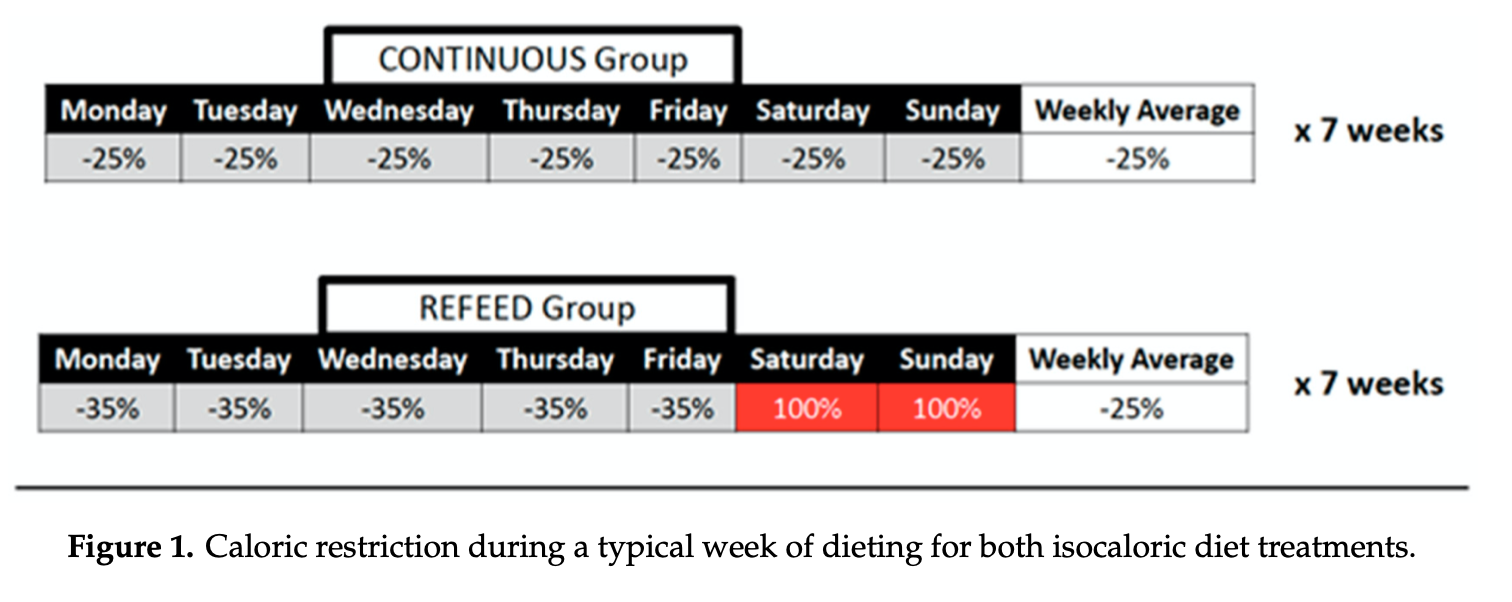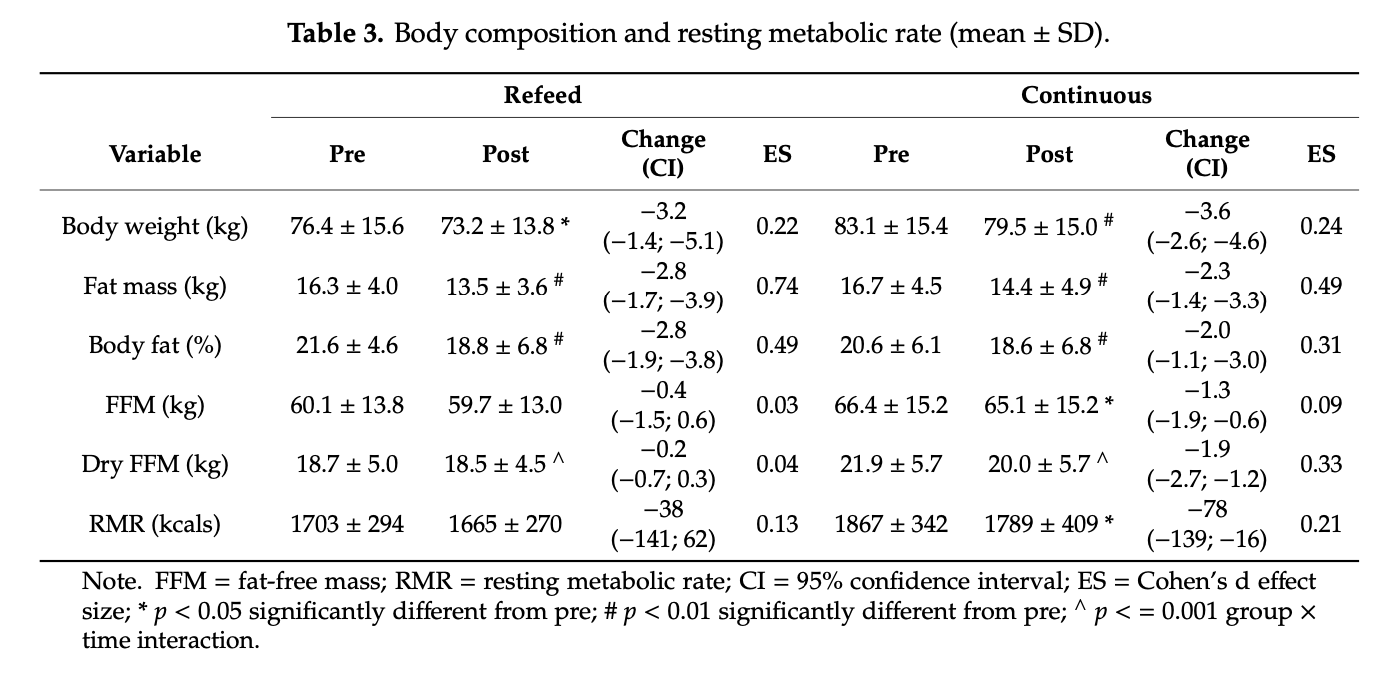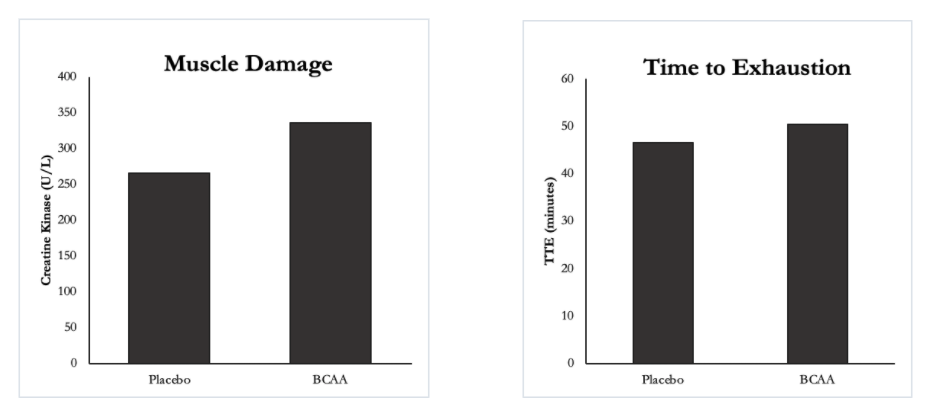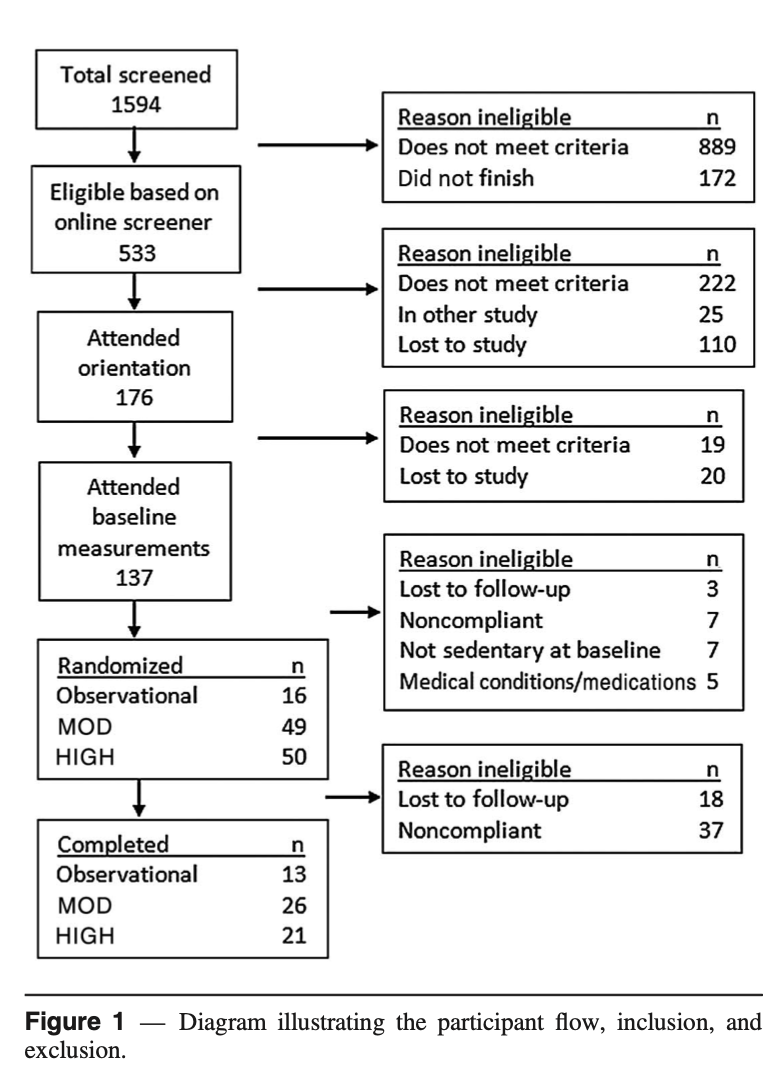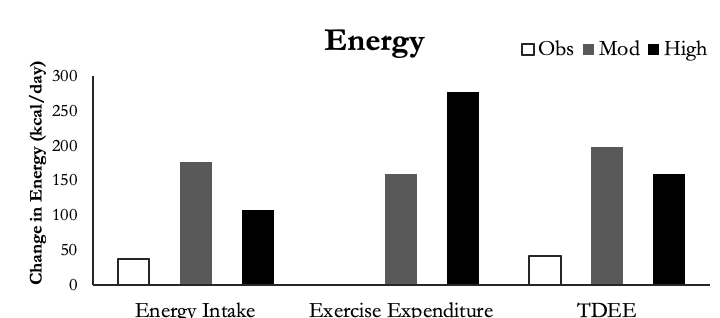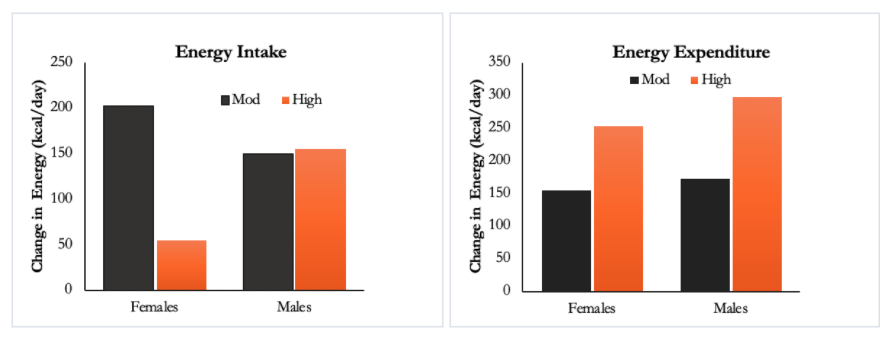Each month I will cover a few of the top research articles on nutrition, training, sleep, supplements, and anything else that might help you. If you’d like me to cover a specific study next month send me a message on Instagram.
[Would you rather listen to this article? If so, check out the podcast we recorded for it – exact same info, spoken in a casual conversation between Brandon and Cody]
Study #1
Big Question: Do refeeds help us retain more muscle and lose more fat while dieting?
Scientific Question: Are there differential body composition changes when comparing 7 weeks of continuous dieting to intermittent energy restriction with 2 refeeds per week while both groups are resistance training?
Who
58 healthy, resistance-trained males and females were recruited, there were 21 drop-outs and 3 withdrawn for compliance issues, which left a total of 32 participants who completed the study. The participants were split into two groups, the refeed group contained 13 while the continuous restriction group contained 14 participants.
Study Details
All participants underwent a 2 week maintenance period prior to being randomly assigned to either a refeed or continuous diet group. Participants were told to consume 1.8g/kg protein throughout the study. In the continuous diet group calories were restricted by 25%, In the refeed group, calories were restricted by 35% during the week, and elevated to maintenance calories during the weekend. You can see a figure of the design below.
Throughout the study, participants completed four resistance training sessions per week, two upper-body, and two lower-body focused sessions. They had a reduction in training during weeks 4 and 8. You can find the training plan in the supplementary files, but it was a typical upper/lower split with 5-6 exercises per workout and progressive overload.
Results
There were no significant differences between the two diet groups for any dietary intake variable. The caloric restriction was 26% and 21% for the refeed and continuous diet groups, respectively.
There were no differences between groups for total workouts completed, training volume, and adherence to the program which was very high (>90%).
The outcome measures can be seen in the table below (table 3 from the study).
Author’s Answer
The authors report that refeeds preserve fat-free mass more than continuous energy restriction. They also mention that the resting metabolic rate was better maintained, albeit slightly, with the 2-day carbohydrate refeed.
My Answer
Dieting with refeeds has been getting a lot of attention in the fitness world lately. The thought is they can help us train harder, diet longer, and adhere to a deficit better. Refeeds have been used in the physique world for some time now, and we’re just starting to see studies using them to find out if they’re really beneficial. In the following breakdown, I get a little tough on this study, but don’t be fooled – the study was worth doing and I applaud the authors for their efforts.
I hate to do this, but I’m going to completely ignore the findings from the resting metabolic rate (RMR) data because of two reasons:
1. “Due to a mechanical issue with the primary metabolic measurement system, seven (five from the continuous group and two from the refeed group) subjects’ RMR was assessed at baseline and post-intervention using a Cosmed FitMate ProTM (Cosmed, Italy).”
Some quick math indicates that the RMR data was on 8 people from the continuous group and 12 in the refeed group were measured on the same machine. This makes the data less reliable – why not remove those subjects from the analysis? What would that do? Another option is to run the analysis with and without that data included to see if it changes the outcome. If it doesn’t then we would be more likely to trust the results.
2. The RMR data wasn’t adjusted for fat-free mass.
This is a somewhat simple thing to do in statistical software packages and would’ve been really beneficial for interpreting the data. The authors do note that fat-free mass plays a role, but we could’ve had an actual answer instead of speculation.
Next up, the important measurement: fat mass and fat-free mass. There was no difference between groups in fat mass lost (~3.2 and ~3.4kg). There were also no differences in fat-free mass between the groups. Then the authors did something smart – they used bioelectrical impedance to try to account for the hydrating effect of glycogen from the refeeds. I say hydrating effect because muscle glycogen attracts water on a 1:4 (ish) scale. So for every 1 gram of glycogen, you would gain an extra 3-4 grams of water. This can be tricky for body composition measures because that water is seen as fat-free mass since it is stored within muscle.
After the author’s adjustment for water, there was a significant difference in dry mass. I don’t have a major issue with the use of bioelectrical impedance or the body composition measures since when done properly they are fairly accurate on a group level. However, I do have an issue of when these measurements were taken. The authors took them at the beginning of the week. They would have been better if they took these measurements at the end of a week of dieting to avoid any issues with glycogen. That would make both groups more comparable.
The average body fat percentage was over 20% in both groups at baseline and by the end of the diet, they were still above 18%. There’s reason to believe that people who have this level of body fat percentage wouldn’t lose much fat-free mass when dieting in general, especially since they were resistance training. The data presented here goes against that idea.
The caloric deficit was 25% of maintenance calories, which is very high and may not be sustainable for long periods. If we do some simple math – on a standard 2000kcal diet that’s dropping down to 1500kcals. Now add in four training sessions per week. That would be fairly difficult to do for 7 weeks. It’s not surprising they had a 48% drop out rate. On the other hand, the average percentage of body weight loss per week was ~0.5% which is in line with the current recommended for physique athletes. There was also a small, albeit insignificant, difference between the groups in total calorie deficit (refeed = 26%, continuous = 21%) that may have had an effect.
Another issue is that there were also no physical activity measurements. This is minor, but we don’t know how active these participants were. Some may have been taking 10,000 steps per day while others could’ve been taking 5,000. However, I think it’s fair to assume they all had similar activity levels and randomization would hopefully take care of any issues.
Another concern is how the study was powered. Power is the probability of detecting an effect if there is one that is present to detect. In sports science research this is a common issue. The participant number simply isn’t high enough to compare between groups for both lean and fat mass. This study was powered “Using data from a similar population in which lean athletes were under investigation for weight loss [12], the effect size calculated for a decrease in fat mass over a period of several months (using a caloric restriction of 20%) was 0.5.” An effect size of 0.5 is moderate and reasonable for a dieting study when looking at fat mass. In fact, the study found an effect size of 0.74 for the refeed group and 0.49 for the continuous group. They were spot on for fat loss. However, when we look at the fat-free mass, it’s no surprise the differences are so marginal within groups. They powered the study on the wrong outcome – the hypothesis was based on muscle mass and RMR, not fat mass.
Finally, the authors were subjects in their own research. Depending on your view, this could break some ethical boundaries. I think the authors are good researchers and they wouldn’t let this influence the data or their interpretation of it.
What’s my interpretation? There were no differences between the two groups. Given the confounders, this study doesn’t support the idea of refeeds being more beneficial than regular dieting for losing fat, retaining muscle, or preserving resting metabolic rate.
How can we apply this?
Don’t take the above section the wrong way. The evidence is building in favor of using refeeds to help with weight loss. The findings of the study under review fit well with others – like the MATADOR study – which found more weight and fat loss were achieved with intermittent dieting. The authors of the MATADOR study argue that interrupting dieting with energy balance ‘rest periods’ may reduce compensatory metabolic responses and, in turn, improve weight loss efficiency, which is somewhat supported by the findings in Campbell et al., However, the MATADOR study was a little different than the current study because the intermittent group had two-week blocks of dieting or energy balance rather than two-day refeeds.
Practically speaking – it’s worth trying refeeds if you’re struggling with a diet. You can plan them or make them reactive to how you are feeling, but know that they will make your diet longer.
What’s next?
The next steps are to do this study accounting for all the methodological issues, with more participants, who are leaner, and for longer periods. It’s difficult to extrapolate changes in someone who is ~20% body fat to someone who ~10-15%. That said, this was a step in the right direction for studying refeeds. Of course, we could try different versions of refeeds, such as 4 on/3 off or any other variation. I think it’s better if we stick to one type so we can replicate the current findings. An easy addition is to add in some hunger and appetite questionnaires to help us understand how the participants were feeling. How people feel is often more important than anything else for adherence.
Study #2
Big Question: Do BCAAs help prevent fatigue?
Scientific Question: Does 20g of BCAAs reduce muscular or central fatigue during an incremental exercise protocol to exhaustion?
Who
Sixteen male long-distance runners (age: 25.7 ± 2.0 years; VO2 max = 50.4 ± 7.2 ml/kg/min) who were members of the Jordan Military Sports Federation.
Study Details
This was a randomized, double-blind trial with a crossover design. This means that groups were tested with both supplements. Double-blind means the participants nor researchers knew which supplement was given. The protocol consisted of two trials: a BCAA (supplement) trial and a placebo trial, which were 14 days apart.
One hour before starting the exercise trial the athletes ingested 20 grams of a BCAA supplement or a placebo. After waiting 45 minutes, the athletes were asked to warm up for 5 minutes on a treadmill at their own pace. Then the time trial started. The pace began at 8 km/h (12-minute mile speed) on a treadmill. Every 5 minutes the speed was increased by 1 km/h (0.62 mph) until exhaustion was reached. Blood samples were taken from all athletes immediately after the completion of each trial.
Results
The BCAA supplement increased time to exhaustion by ~3.8 minutes compared to placebo. Since the BCAA group was able to run for a longer period they also had a higher speed (19km/h or a 5:05 mile pace) compared to the placebo group (18km/h or a 5:22 mile pace). When we look at the data on muscle damage measured by creatine kinase, we see that there was a 26% increase in the BCAA group. The BCAA also significantly decreased serotonin and free-fatty acids.
Author’s Answer
The authors found that time to exhaustion was increased by pre-exercise administration of BCAAs, which could be due to the role of BCAAs in sustaining prolonged physical effort.
My Answer
BCAAs have been popular for a long time. They recently had some blowback in the fitness world because they didn’t have the effects of increasing muscle protein synthesis or decreasing muscle protein breakdown to the same extent as whey protein. They also were intertwined with fasted cardio for a while because they were seen as not breaking the fast (they did). However, on the scientific side, they seem capable of doing two things: reducing muscle soreness and increasing acute endurance performance.
BCAAs are unique to other amino acids because they are initially broken down in skeletal muscle and can be used by the brain. As we are exercising, the concentration of free tryptophan increases and is used by the brain. When this occurs, 5-hydroxytryptamine (serotonin) – which can induce feelings of fatigue – is produced. Since BCAAs are transported into the brain by the same carrier system as tryptophan they can compete with tryptophan. Therefore, if you take BCAAs it can decrease the uptake of tryptophan in the brain and ultimately decrease feelings of fatigue.
A comparable study on BCAAs found that there were lower elevations in creatine kinase (a marker of muscle damage) compared to placebo after cycling at 70% VO2 max to exhaustion which is the opposite of this study found, yet that study also found BCAA lowered serotonin levels during exercise. It’s plausible that creatine kinase would be higher in the current study because the BCAA group exercised for longer. Interestingly, there may be benefits of chronic BCAA supplementation to enhance endurance exercise capacity.
The odd part about this study was the dose they gave participants (20 grams). That’s a ton of BCAA and much more than you would find in a typical supplement serving or even a protein shake. Given that plenty of other research has found similar data in cyclists with less BCAA, I’m inclined to believe there is some benefit to acute BCAA supplementation before a hard endurance session – the real question is would a normal protein shake be similar? We don’t know because that study hasn’t been done yet, and if it was we would need to match the doses of BCAA.
How can we apply this?
Taking 15-20 grams of BCAA about 1 hour prior to a long endurance session could help you go farther or faster because of reduced fatigue. There is also some data to suggest taking BCAA could help with muscle damage too.
What’s next?
I think long-term studies on athletes with high protein intake would be beneficial. If we constantly have high levels of BCAA then an acute dose may not make a difference. There is also a chance that we adapt to taking BCAA so there isn’t as much of a benefit in reducing fatigue.
Study #3:
Big Question: Does exercise change your daily energy expenditure?
Scientific Question: What is the effect of increasing doses of exercise energy expenditure (EEex) on changes in total daily energy expenditure (TDEE), total body energy stores, and body composition?
Who
Sedentary men and women age ~30 years who were overweight or obese and weight stable.
Study Details
The study followed three groups of participants for 7 months while they were on a training program or not training (observational group). The program consisted of supervised treadmill exercise with a max heart rate of 70 – 75%. Each participant’s dose of the exercise was determined as weekly energy expenditure per kg of body weight. Participants in the moderate group were asked to do 17.5kcal/kg/week while the individuals in the high group targeted an EEex of 35 kcal/ kg/wk. The third group was observed and no exercise was prescribed.
To put that in perspective, a male like myself (165lb = 75kg) would do 1312kcal of exercise per week in the moderate group and 2625kcal in the high group.
Importantly, participants were removed from the study if bodyweight changed by more than 5%, or if 6 or more exercise sessions were missed in 1 month. This led to losing 55 people out of the original 115, which is a 52% drop out rate. That may mean this type of program isn’t as practical for some people.
Results
Most of the participants were overweight (82%) at the start of the study, with the average body fat percentage around 30% for men and 39% for women. There were no significant changes in fat-free mass or fat mass between groups during the study, which was the goal.
The moderate exercise group increased energy expenditure by 161 kcal/day or by about 15% which took roughly 2 hours and 40 minutes per week. The high exercise group increased energy expenditure by 277 kcal/day or by about 27% which took roughly 3 hours and 43 minutes per week.
There were no differences in resting metabolic rate (RMR) among groups at baseline or any changes during the training period. You can see most of the data in the table below.
One of the more interesting findings was the differences in energy intake between the groups. Basically, since the study had people maintain their weight they had to adjust their caloric intake to be higher if they had to exercise more. From a practical standpoint, if the moderate exercise group didn’t change anything they would’ve lost about 1 pound per month, while the high exercise group would’ve lost about 2 pounds per month. This isn’t much although it might add up over 7 months.
This graph shows changes in energy dynamics among the groups. The only significant differences were the exercise expenditure in the mod and high groups compared to the observational group, which we would hope was different since the observational group wasn’t exercising.
Author’s Answer
The stepwise increase in exercise-induced energy expenditure across groups did not result in an equivalent increase in TDEE. In contrast to the similar increase of EEex and TDEE among the individuals in the MOD group, the increase in TDEE among the individuals in the HIGH group was lower than the achieved daily average of exercise energy expenditure. While all individuals included in the analyses maintained body weight within 3% of baseline measurements, female individuals in the HIGH group lost more bodyweight than those in the OBS or MOD groups, and the weight loss was entirely due to a loss of fat mass.
My Answer
Some people may start an exercise program to lose weight. They make the assumption that increasing the number of calories they burn will lead to weight loss. They don’t think about any compensatory changes like eating more or reducing their non-exercise activity. However, we know from research that exercise doesn’t cause a lot of weight loss independent of nutrition changes because components of energy balance are interrelated. This study further supports that idea. They found participants total daily energy expenditure (TDEE) was offset, especially in the high exercise group, by compensatory changes.
When splitting the data up by sex, the authors found a stepwise reduction in fat mass among the women in the exercise groups, but not among the men. This means that women’s body composition improved even though their weight didn’t. Previous studies have shown similar effects in women who reduced overall fat mass by increasing energy expenditure through exercise while maintaining body weight. This tells us that men may be more prone to eating more or moving less when we tell them to exercise. If we look at the two graphs below we can see stark differences in energy intake in females between the two exercise groups. females in the high group at way less than anyone else. In the energy expenditure graphs, we see the two sexes are about the same.
The other thing I’d like to point out is that these participants were exercising for a decent amount of time (2-4 hours). After some digging – it looks like they were doing 5 sessions per week, which would be 30-45 minutes per day depending on the group. That’s a lot of cardio.
Ultimately, this study shows that doing cardio may not translate to a proportional increase in TDEE. Since the increase in TDEE for the MOD group was about 6%, and that for the HIGH group was about 11%, compensatory mechanisms may become a factor in the 8% to 10% range of TDEE. However, participants were told to maintain their weight and a lot of them dropped out, so we don’t know what would’ve happened in a more real-world setting.
How can we apply this?
We have to adjust our expectations. Exercise can only take you so far. If we want to lose weight we need to diet too. This study also highlights how some people adjust their energy intake to counter their exercise. The findings also suggest that we should monitor non-exercise activity. One method to do that is with your watch or phone.
What’s next?
This is one area of research where we have a lot of data suggesting people compensate for an increase in exercise. The next step is to figure out who those people are before we start them on an exercise plan.


